Technical Data Large size conveyor chain Selection
2. Decide Conveyor Type
| Basic Conveyor Types | Conveyed object | |||
|---|---|---|---|---|
| Solid Conveyance | Chain model | Bulk items | Chain model | |
| Direct Loaded on the Conveyance | ・Horizontal Slat Conveyor 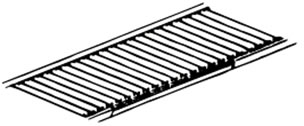
|
RF- [BR/BF] RF-(NB) RF RF-[DBR/DBF] |
・Apron/Pan Conveyor 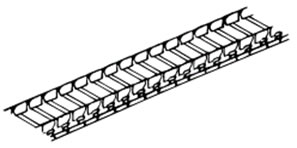
|
RF RF-(KG/KA) |
・Push Conveyor, Tow Conveyor, Roller Coaster 
|
RF RF-(NB) NF RF-<SR> |
|||
・Free Flow Conveyor 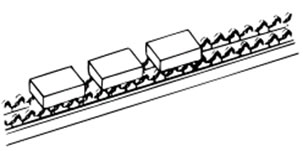
|
RF-[VR] RF-<SR> RF-<TR> |
|||
・Standard Chain Conveyor 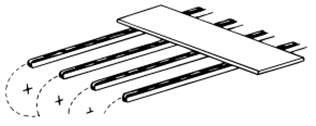
|
RF NF RF-(DL) |
|||
| Suspension Conveyance | ・Trolley Conveyor | RF RF-<TRO> |
・Bucket Elevators | RF B |
・Tray Elevator 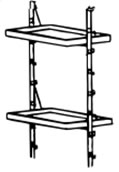
|
RF NF |
・Fly Ash Bucket Conveyor 
|
RF-(FB) | |
・Vertical Parking Tower 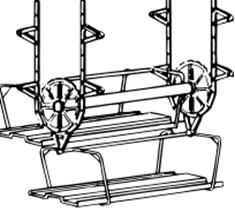
|
RF Specialty Chain |
・Bucket Type Continuous Unloader | Specialty chain | |
| Push Conveyance, Frictional Conveyance | ・Push Conveyor 
|
RF NF RF-(NB) |
・Scraper/Flight Conveyor 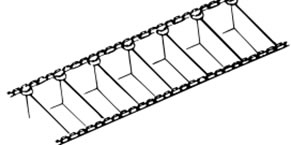
|
RF RF-(AM/AP) RF-(FG/FP) |
・Horizontal Revolving Conveyor 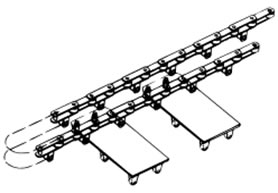
|
RF RF-(NB) RF-<GR> |
・Flow Conveyor 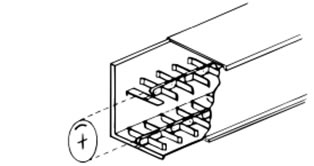
|
RF NFX |
|
| ・Drag Chain Conveyor | WD | |||
Note)
- 1. See "Corrosion Resistance to Various Kinds of Solvent" regarding item wear and corrosion properties.
- 2. ( ) indicates specification code, [ ] roller type, and < > dedicated attachment types.
3. Decide Chain Model
When selecting conveyor chain type, it is necessary to identify the physical properties of the materials conveyed. Method of conveyance and chain conveyor model should then be determined, keeping cost performance in mind.
Three basic types of conveyor are shown on the above table, which can be used for determining conveyor chain model.
| Key Points in Determining Conveyor Chain Model |
|---|
|
4. Decide Roller Type
Refer to “Roller Types” in the pages of Large size conveyor chain construction.
5. Basic Conveyor Chain Layout
5.1 Horizontal Conveyor
Partial or full support by catenary on the return side (see lower part of figure below) can absorb chain elongation/shrinkage from heat or other factors. This arrangement can be used when chain speed is comparatively slow. Catenary sag should be about 10% of the free span. This is not recommended for reverse drives
1) Making a catenary on the drive sprocket side

Benefits
- 1) Catenary tension makes chain-sprocket engagement smooth.
- 2) Lubrication at the catenary is most effective.
2) No guide on the return side

For short center distance and slow chain speed.
The mass of the chain on the return side may cause vibration, affecting chain operation.
3) Supporting the chain on the return side with guides or rollers
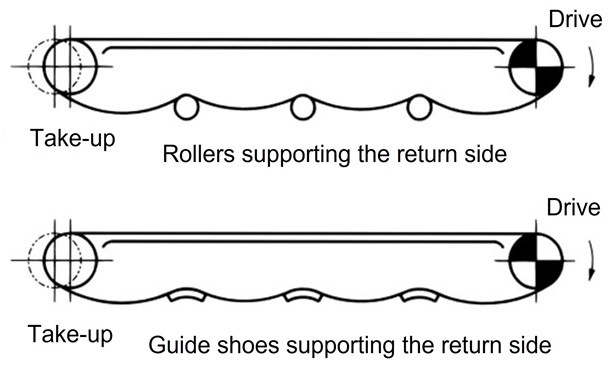
Contact between chain and guide or roller may hasten chain wear or damage chain as it articulates at the roller or guide.
This may also cause vibration, affecting chain operation. With a long center distance, it is practical to divide the return side into several catenaries.
4) Supporting the entire return side

The return side is entirely supported by rails, which are fixed on the take-up of the driven sprocket. This method absorbs all chain sag, and can also be used in reverse operation.
However, there is no catenary on the drive sprocket lower side, making it necessary to regularly adjust chain elongation through take-up.
Note) Excessive tension from take-up will hasten chain wear.
5) Return side on top

5.2 Vertical Conveyors
If the conveyor will be stopped while loaded, it will be necessary to install a brake or Tsubaki Back Stop Cam Clutch to prevent reverse operation.
Note) Excessive tension from take-up will hasten chain wear.

5.3 Inclined Conveyors
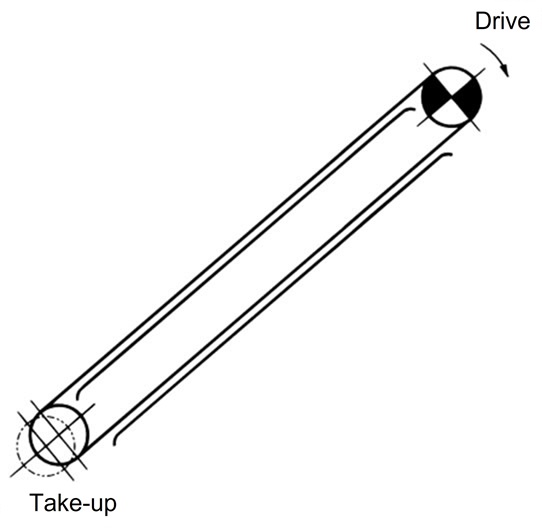
5.4 Vertical Shaft Conveyors

Installing a guide roller will help the chain run smoother
| Key Points in Using Conveyor Chains |
|---|
|
6. Choose a Chain Series for Conveying Bulk Materials
The following table lists the chain conveyor types and chain series used in conveying typical bulk materials, as well as our recommendations.
Depending on the conveyed items, the same items listed in Table 1 may differ in condition or quality. Determine conveyor type and chain series based on consideration of past performance and careful investigation.
Table 1. Material and Chain Specifications
- 1. Abrasiveness: A → B → C
- 2. Corrosiveness: A (strong acid), B (moderate acid), C (neutral), D (moderate alkali), E (strong alkali)
- 3. Refer to clean specifications.
| Conveyed object | Type of Conveyor | Recommended Chain Specification code | Note | |||||
|---|---|---|---|---|---|---|---|---|
| Product name | Wear | Corrosion | Scraper Conveyor | Flow Conveyor | Apron Conveyor | Bucket Elevators | ||
| Rice | Low | neutral | ○ | ○ | ○ | DT | ||
| Barley | Low | neutral | ○ | ○ | ○ | 〃 | ||
| Wheat | Low | neutral | ○ | ○ | ○ | 〃 | ||
| Soybean | Low | neutral | ○ | ○ | ○ | 〃 | ||
| Corn | Low | neutral | ○ | ○ | ○ | 〃 | ||
| Wheat Flour | Low | neutral | ○ | ○ | ○ | 〃 | ||
| Starch | Low | neutral | ○ | △ | △ | 〃 | ||
| Sugar Cane | Low | neutral | ○ | ○ | DTA | |||
| Bagasse | Low | neutral | ○ | DTA | ||||
| Sugar Refining | Low | neutral | ○ | ○ | ○ | SS | See Note 3. | |
| Rock Salt | Low | neutral | ○ | △ | △ | DT | ||
| Mixed Feed | Low | Acid | ○ | △ | △ | 〃 | ||
| Soda Ash | Medium | Strong Alkali | ○ | △ | △ | 〃 | ||
| Carbide | Medium | ○ | ○ | ○ | ○ | 〃 | ||
| Glauber's Salt | Medium | Acid | △ | GS | ||||
| Dry Unslaked Lime | Medium | Strong Alkali | ○ | △ | △ | DT | ||
| Dry Slaked Lime | Low | Strong Alkali | ○ | △ | △ | 〃 | ||
| Polyethylene | Medium | neutral | ○ | △ | △ | 〃 | ||
| Vinyl Chloride Powder | Medium | △ | △ | MT | ||||
| Carbon | Medium | neutral | ○ | △ | △ | BT | ||
| Activated Charcoal | Medium | neutral | ○ | △ | △ | DT | ||
| Dry Ammonium Chloride | Low | neutral | ○ | △ | △ | 〃 | ||
| Dry Ammonium Sulfate | Medium | Acid | ○ | △ | △ | 〃 | ||
| Dry Urea Powder | Low | neutral | ○ | △ | △ | 〃 | ||
| Wet Urea Powder | Medium | Strong Alkali | ○ | △ | △ | GS | ||
| Synthetic detergent | Medium | neutral | ○ | △ | △ | DT | ||
| Wet Gypsum | Medium | Strong Acid | ○ | ○ | ○ | GS・RT | ||
| Dolomite | Medium | Alkali | ○ | △ | ○ | △ | DT | DTA on Apron Conveyors |
| Dry Limestone | Medium | Alkali | ○ | △ | ○ | △ | 〃 | DTA on Apron Conveyors |
| Dry Clay | Medium | neutral | △ | △ | BT | |||
| Cement Clinker | High | Strong Alkali | ○ | △ | ○ | △ | CT | |
| Cement Products | Medium | Strong Alkali | ○ | ○ | CT | |||
| Dry Wood Chips | Low | Alkali | ○ | △ | DT | |||
| Dry Sawdust | Low | Alkali | ○ | △ | DT | |||
| Coal | Medium | Acid | ○ | ○ | CT | |||
| Coke | High | neutral | ○ | △ | BT | |||
| Alumina | Medium | Strong Alkali | △ | △ | CT | |||
| Foundry Sand | High | neutral | ○ | △ | BT | |||
| Scale | Medium | neutral | ○ | △ | △ | BT | ||
| Coke Dust | High | neutral | △ | BT | ||||
| Wet Coal Dust | Medium | Acid | △ | BT | ||||
| Clinker Dust | High | Strong Alkali | △ | BT | ||||
| Garbage | Medium | △ | ○ | RT | ||||
| Incinerated Garbage (Room temperature/ Dry ) |
Low | Alkali | ○ | DTA | ||||
| Incinerated Garbage (Wet ) |
Low | Alkali | ○ | RT | ||||

